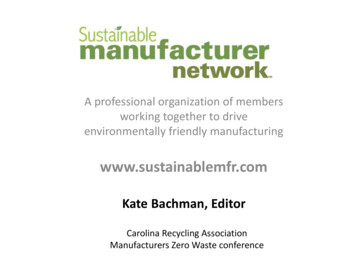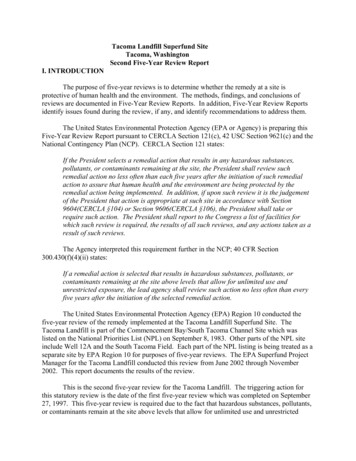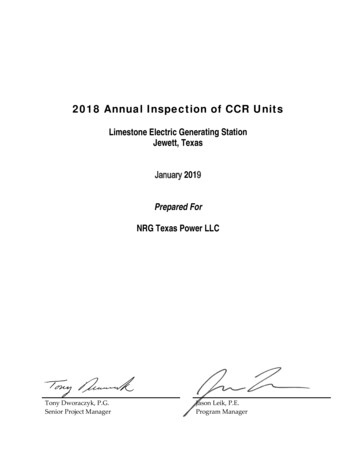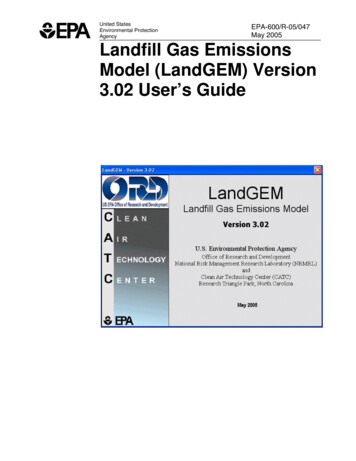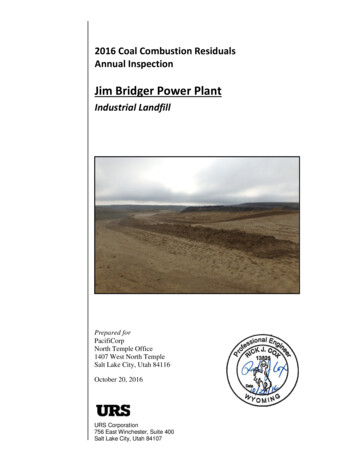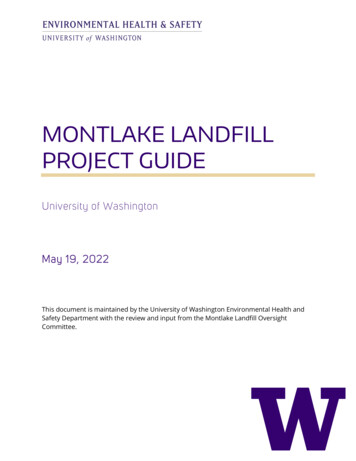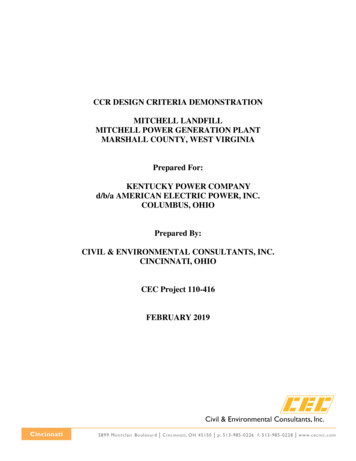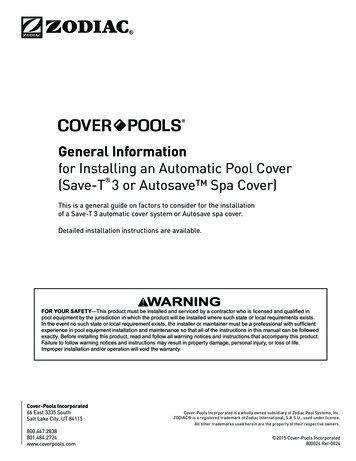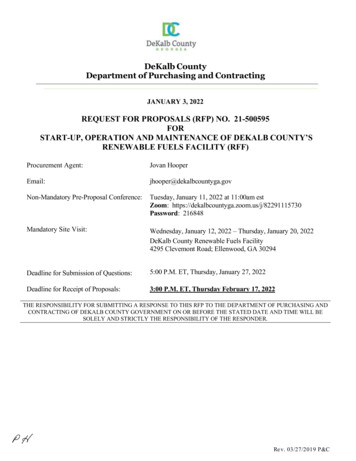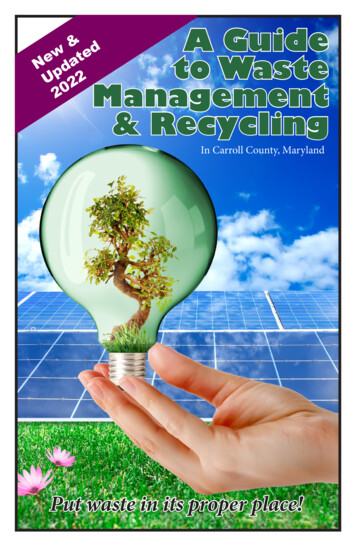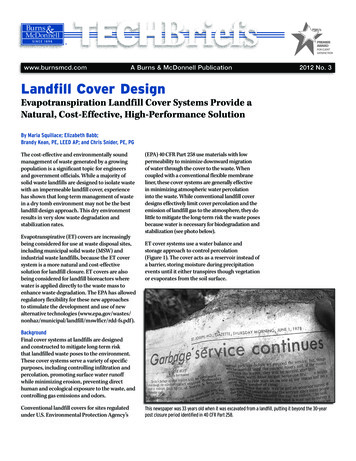
Transcription
TECHBriefswww.burnsmcd.comA Burns & McDonnell Publication2012 No. 3Landfill Cover DesignEvapotranspiration Landfill Cover Systems Provide aNatural, Cost-Effective, High-Performance SolutionBy Maria Squillace; Elizabeth Babb;Brandy Kean, PE, LEED AP; and Chris Snider, PE, PGThe cost-effective and environmentally soundmanagement of waste generated by a growingpopulation is a significant topic for engineersand government officials. While a majority ofsolid waste landfills are designed to isolate wastewith an impermeable landfill cover, experiencehas shown that long-term management of wastein a dry tomb environment may not be the bestlandfill design approach. This dry environmentresults in very slow waste degradation andstabilization rates.Evapotranspirative (ET) covers are increasinglybeing considered for use at waste disposal sites,including municipal solid waste (MSW) andindustrial waste landfills, because the ET coversystem is a more natural and cost-effectivesolution for landfill closure. ET covers are alsobeing considered for landfill bioreactors wherewater is applied directly to the waste mass toenhance waste degradation. The EPA has allowedregulatory flexibility for these new approachesto stimulate the development and use of newalternative technologies ficr/rdd-fs.pdf).(EPA) 40 CFR Part 258 use materials with lowpermeability to minimize downward migrationof water through the cover to the waste. Whencoupled with a conventional flexible membraneliner, these cover systems are generally effectivein minimizing atmospheric water percolationinto the waste. While conventional landfill coverdesigns effectively limit cover percolation and theemission of landfill gas to the atmosphere, they dolittle to mitigate the long-term risk the waste posesbecause water is necessary for biodegradation andstabilization (see photo below).ET cover systems use a water balance andstorage approach to control percolation(Figure 1). The cover acts as a reservoir instead ofa barrier, storing moisture during precipitationevents until it either transpires though vegetationor evaporates from the soil surface.BackgroundFinal cover systems at landfills are designedand constructed to mitigate long-term riskthat landfilled waste poses to the environment.These cover systems serve a variety of specificpurposes, including controlling infiltration andpercolation, promoting surface water runoffwhile minimizing erosion, preventing directhuman and ecological exposure to the waste, andcontrolling gas emissions and odors.Conventional landfill covers for sites regulatedunder U.S. Environmental Protection Agency’sThis newspaper was 33 years old when it was excavated from a landfill, putting it beyond the 30-yearpost closure period identified in 40 CFR Part 258.
PrecipitationSurface Water ovementFinalCoverWasteCover PercolationMaria Squillace is a graduateFigure 1: Evapotranspirative landfill cover using the natural water balance to store and release moisture.ET covers also have design flexibility. They canbe designed to either limit percolation if requiredby applicable regulations or enable controlledpercolation through the cover in a way thatenables the underlying waste to receive moisture.(Figure 2). In a monolithic soil cover, a singlevegetated soil layer is used to retain water andsupport the vegetation, which is essential to theperformance of the cover system.A monolithic cover can be modified through theaddition of a capillary break. A coarser material,typically a sand or fine gravel, is placed underthe monolithic fine-grain soil. The differences inthe unsaturated hydraulic properties betweenthe two layers minimize percolation into thecoarse layer. Generally, the difference in poresizes between the finer and coarser materialforms a capillary break at the interface of thetwo layers. Capillary forces hold the water in thefine-grained layer until the soil near the interfaceapproaches saturation.When leachate collection and liner systems are inplace below the waste, ET covers can be designedto allow limited percolation, therefore enabling thecontrolled degradation of waste and an associatedreduction of long-term environmental risk.Design DescriptionInstead of installing materials with lowhydraulic conductivity, ET cover systems relyon the water storage capacity of the soil layer.Percolation decreases through the cover systemas storage capacity and evapotranspirativeproperties increase. Typically, an ET coverdesign emphasizes:The fine-grain material serves the same purposein the capillary barrier design as it does inthe monolithic layer: It stores water until itis naturally removed by the environment. Ifsaturation occurs, the water is transferred intoand through the coarser layer to the waste below. High storage capacity materials including finegrained soils, such as silt. Increased evapotranspiration through nativevegetation.In addition to potentially being less costly toconstruct than conventional cover systems,ET covers could also deliver equal or evensuperior performance. This is particularly truein arid and semi-arid environments. Within Simplified construction and cost savings withlocally available soils.Two general types of ET cover systems exist:monolithic barriers and capillary barriersTECHBriefs 2012 No. 3student at the South DakotaSchool of Mines & Technology andis pursuing a master’s degree inenvironmental engineering.She earned her bachelor’s degreein environmental engineeringfrom the South Dakota School ofMines & Technology.2Burns & McDonnellElizabeth Babb is anenvironmental engineer inthe Environmental group atBurns & McDonnell. She earnedher bachelor’s degree inenvironmental engineering fromthe Missouri University ofScience & Technology.
these environments, ET covers are less prone toweakening through dehydration, cracking andfreeze/thawing cycles.causes high runoff over a short period of time,or conditions during cool winter weatherwith persistent, light precipitation. Ideally, themajority of precipitation will occur during theperiods of greatest transpiration.The capillary barrier design has an added benefitin that the lower coarse material can serve as aneffective horizontal landfill gas collection layer whenoperated at low vacuum. Landfill gas collection linescan be placed in the lower coarse material to collectlandfill gas for beneficial use or combustion.Brandy Kean, PE, LEED AP,is a project manager in theEnvironmental group atBurns & McDonnell. She earnedher bachelor’s degree in civilengineering at the South DakotaSchool of Mines & Technology.Soil PropertiesThe storage capacity of the soil is governed bysoil texture, which defines the particle size, shapeand gradation of the soil. The bulk density ofsoil is impacted by compaction, which affectsthe storage capacity of the soil and plant rootzones. Minimizing the amount of compactionduring placement is a key aspect of ET coverconstruction. Higher bulk densities may reducethe storage capacity of the soil and inhibit rootgrowth. The required thickness of each soil typedepends on the required storage capacity. Thesoil layers are designed to accommodate extremeprecipitation conditions during both dormantand flourishing plant conditions.General ConsiderationsThe design of ET cover systems is based onsufficient data associated with water storagecapacity and evapotranspiration, which controlsmoisture and water percolation. Designconsideration categories involved in the designof ET covers include climate, soil properties,vegetation types and software inputs.ClimatePrecipitation and other atmospheric factors— such as humidity, temperature, wind speed,cloud cover and solar radiation — strongly affectthe performance of an ET cover. Ultimately,the success of an ET cover depends on theprecipitation and evapotranspiration cycle.This cycle varies greatly from site to site.For example, the cover may need toaccommodate a spring snowmelt event thatVegetation TypesTranspiration is one of the primary mechanismsfor removing water from the ET cover.Plant roots uptake water from the soil andconvey it to the atmosphere, which helpsstabilize the soil moisture content. Establishedvegetation also helps minimize erosion bystabilizing the cover.ET Cover DesignsMonolithicChristopher J. Snider, PE, PG,is a department manager in theEnvironmental group atBurns & McDonnell. He earnedbachelor degrees in civilengineering and geology at theUniversity of Missouri-Columbia.For more information, please kean@burnsmcd.com orcsnider@burnsmcd.com.Capillary erimCoverWasteLFG Extraction WellGroundwaterMonitoring WellBottom LinerSystemLandfillAreaFigure 2: Typical landfill with conceptual designs for a monolithic and capillary barrier ET final cover.Burns & McDonnell3TECHBriefs 2012 No. 3
Several factors should be considered whenchoosing vegetation for an ET cover:than for traditional landfill caps at Air Force baselandfills across the United States. Additionally,less-intricate repairs further reduce long-termoperations and maintenance costs. Historical establishment of seed mix Experience with borrow soils Growing season Ground cover Root structure and depth Leaf area index Evapotranspiration Soil amendment requirementsET Cover Design Potential LimitationsET covers can have site-specific limitationsowners and designers should consider. In atraditional landfill cover design with a flexiblemembrane liner, the membrane controls thetransmission of gas through the cover. This gastransmission control is useful to limit both theemission of landfill gas to the atmosphere andthe introduction of atmospheric gas into thelandfill by the gas collection system. Landfill gascollection systems are operated under vacuum.The operation of gas collection systems withconventional covers can be less operator-intensivewhen compared with an ET cover design because,when coupled with a flexible membrane liner inthe cover, the flexible membrane liner prohibitsthe mixing of landfill gas and atmospheric air. Thesensitivity of a particular landfill gas collectionsystem is site- and design-specific. Ownersand designers are encouraged to evaluate thispotential limitation when considering an ET cover,especially for landfills regulated under EPA 40CFR, Part 60, Subpart WWW.Technical guidance documents and engineeringbest practices have shown that the benefit of early,strong vegetation establishment is one of the mostimportant factors for cover performance.Software InputsWinUNSAT-H, created by the University of Wisconsin,is Windows-based software used to evaluate theeffectiveness of varying depths of final ET coverusing site-specific data. WinUNSAT-H simulateswater balance quantities for runoff, evaporation,transpiration, soil water storage and percolation.Key attributes of the WinUNSAT-H model: Simulation of the removal of water throughoutthe soil profile via plant transpiration Surface boundary driven by site-specificmeteorological data that simulates interactionsamong the soil, plants and atmosphere Lower boundary accounting for interactionsbetween the cover and underlying waste S oil profile divided into nodes with derivativesapproximated by slopes between adjacent pointsDataLoggerSome WinUNSAT-H input parameters for soiland vegetation are described in Table 1.Soil WaterContentProbesCost ConsiderationsET covers have not only demonstratedenvironmental integrity, but are also a costeffective alternative to conventional landfillcaps. Significant construction cost savingswere documented by the Air Force Center forEngineering and the Environment survey, “Surveyof Air Force Landfills, Their Characteristics, andRemediation Strategies.” Results of this surveyindicated construction costs for ET covers wereapproximately 119,000 to 321,000 less per acreTECHBriefs 2012 No. 3Pan LysimeterMeasured CoverPercolation(mm/yr)Figure 3: Measuring cover percolation performance.4Burns & McDonnell
Key WinUNSAT-HModel InputsET Cover Instrumentation and MonitoringConsiderable research has been applied tothe design and numerical modeling of coverperformance. When considering that ET coversare a relatively new approach, the installation ofa lysimeter in the cover system is encouraged —especially if the cover is designed to transmit acertain quantity of water to the underlying wasteto promote waste degradation.Comments/ExplanationSoil InputTortuosityComparison of the direct path (straight-line distance) to the increased pathlength due to porous media. Provides a comparison of diffusion in a porousmedia to an open area.Saturated Water Content (θs)Condition occurs when there is no suction. Suction takes place when the soil isunsaturated and water clings to the soil pores (negative soil water pressure).Residual Water Content (θr)Condition occurs when there is no additional water which can be removedfrom the soil in a realistic setting.Coefficient of van GenuchtenFunction (α)Inversely related to the suction at which the largest soil pores drain of water.As “α” decreases the point at which the hydraulic conductivity begins todecline occurs at a higher suction.The “n” ExponentAffects the slope of the Soil Water Characteristic Curve (SWCCC). As “n”increases, the hydraulic conductivity more rapidly declines as the suctionincreases and vice versa.Saturated Hydraulic ConductivityDefines the rate at which water is able to move through the soil when the soilpores are completely filled with water.Exponent of PoreInteraction Term (l)Directly influences how the unsaturated hydraulic conductivity (rate at whichwater is able to move through the soil when the soil pores are completelyor partially filled with air) changes with respect to suction. As l decreases,a more gradual decrease in unsaturated hydraulic conductivity occurs assuction increases.A lysimeter collects the cover percolation waterand enables the cover flux to be quantified(Figure 3). The installation of a lysimeter in a coverpilot project is an excellent way for owners anddesigners to evaluate the long-term performanceof a full-scale ET cover in advance of full-scalecover construction. Instrumentation that providesmoisture sensing coupled with automatic datalogging represents an enhanced instrumentationapproach to evaluate a site-specified design.SummaryET cover systems represent a significant landfilldesign enhancement in the practice of solidwaste engineering. The increasing popularityand continued success of monitored ET coversindicate that ET cover design is here to stay.Plant Information InputInitial Suction HeadTypically defined as the wilting point or reassigned based on multiple yearsimulation using average year meteorological data for the Site. Representsinitial conditions existing at the Site.Day of the Year on whichSeeds GerminateAffects the time period when water can be removed via transpirationthroughout the year. Site specific planting/growing dates are used.Day of the Year on which PlantsCease TranspiringAffects the time period when water can be removed via transpirationthroughout the year. Site specific planting/growing dates are used.Fraction of Soil Surface that is Bareof PlantsThe amount of soil surface without vegetative cover. Provides a conservativeestimate of vegetative cover based on site-specific plant data.LAI Values throughout the YearLeaf Area Index (LAI) is the area of leaves relative to the area of soil surface.The LAI varies throughout the year and defines the amount of leaf areaavailable for transpiration.Instead of using conventional materials with alow permeability to keep moisture out, ET coversystems use a water balance approach to limitpercolation. Site-specific borrow soil samplingand characterization followed by numericalmodeling of cover performance is critical todeveloping a successful ET cover system design.This early investment in design effort pays adividend because ET covers cost less to constructcompared with traditional covers.Root Growth Exponential Relationship InputRoot Density Function(Coefficient a, b, & c)Indicates the distribution of roots versus depth. Directly affects the dispersion oftranspiration through the root zone.Plant Water Intake InputHead Corresponding to Water Contentbelow which Plants Wilt and StopTranspiring, cmSuction at which transpiration no longer occurs.Head Corresponding to Water Contentbelow which Plant Transpiration starts toDecrease, cmSuction at which water flow through the plant is impeded.Head Corresponding to Water Contentbelow which Plants do not Transpirebecause of Anaerobic Conditions, cmSuction at which oxygen diffusion to the root zone is obstructed due to water.The construction of an ET cover pilot with anunderlying lysimeter is an excellent way toevaluate a site-specific design prior to buildinga full-scale cover. Lysimeters also provide anopportunity for owners, engineers and regulatorsto fully understand how a particular cover willperform and provide for a level of comfort thatmodeling alone may not provide. As interestgrows in exploring alternatives different from thedry tomb application, ET covers offer a modernapproach to provide limited moisture to thewaste, enabling controlled waste degradationand the associated reduction in long-term risk.Daily Meteorological InputMeteorological DataSite specific daily data for maximum air temperature, minimum airtemperature, dew point temperature, solar radiation, average wind speed,and precipitation.Table 1: K ey model input parameters for WinUNSAT-H software for ET cover modeling and design.Burns & McDonnell5TECHBriefs 2012 No. 3
including municipal solid waste (MSW) and industrial waste landfills, because the ET cover system is a more natural and cost-effective solution for landfill closure. ET covers are also . University of Missouri-Columbia. Brandy Kean, PE, LEED AP, is a project manager in the Environmental group at Burns & McDonnell. She earned
